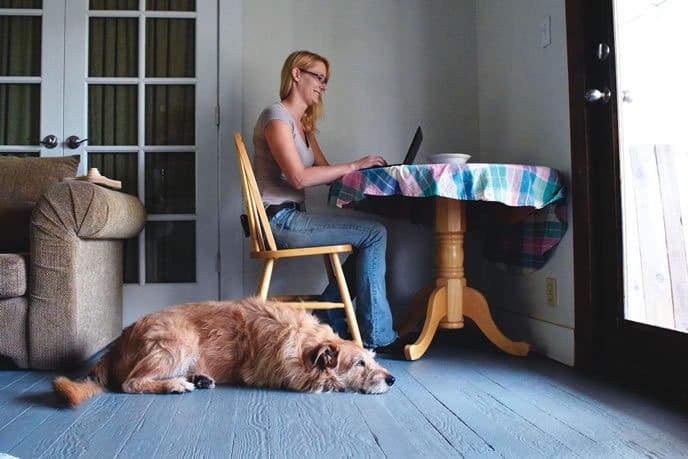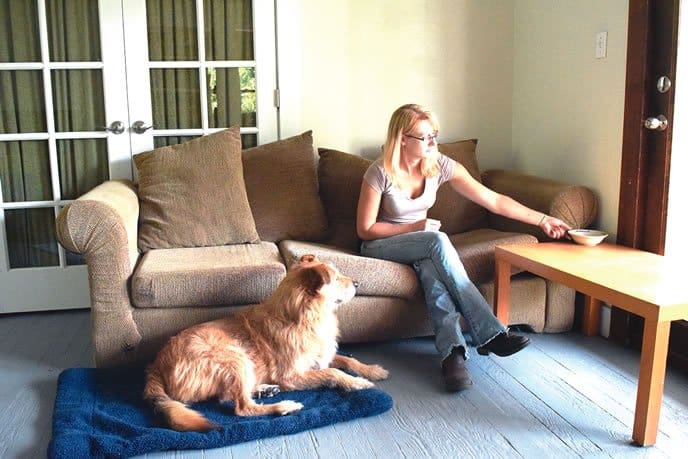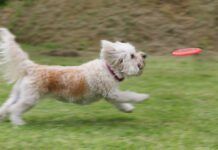
Sit. Target. Go out. Jump. Fetch. Roll over. Turn on the light. Close the door. In sharp contrast to the rigid, behavior-suppressing training methods of days gone by, we in the modern, positive reinforcement-based training world take great pride in our ability to get our dogs to do lots of stuff. Fun stuff. Creative stuff. In our zeal to teach behaviors and encourage our dogs to offer behaviors, we sometimes overlook the importance of being able to ask our dogs to turn it off, settle down, and relax. That can be a serious oversight.
In the Basic Good Manners classes at my training facility (Peaceable Paws in Fairplay, Maryland), we always teach a “settle” exercise. This is just partly to prevent the dog owners from creating a dog who is so happy about receiving treats for doing stuff that she learns to offer demand behaviors in order to keep the reinforcement coming.
These dogs are easy to spot. When there’s a pause in the action – say, when the instructor is explaining the next exercise or giving the class a short break – you may hear a low “Woof” from one corner of the room. While some dogs are happily relaxing on their mats, lapping from their water bowls, or sniffing the ground, this dog is sitting bright-eyed in front of and making meaningful eye contact with her human.
“Woof!” she says, as the bark gets sharper and more insistent. “Let’s keep doing stuff! I’d like more treats, please!” she seems to say. And the owner, in an attempt to avoid disrupting the class, feeds treats to keep the dog quiet.
“Well, now,” the dog thinks to herself. “Barking is yet one more behavior that gets reinforced. I believe I’ll bark again!”
This is a great place to insert a reminder about one of the basic tenets of positive reinforcement training: Feed/reinforce the behavior you want. Reinforcement increases – or at least maintains – a behavior. If you feed barking, you get barking!
Ideally, you will teach your dog the “Settle” behavior before she learns to bark for reinforcement, but the exercise can also be used to modify the behavior of a demand barker. (In the meantime, you can preempt a demand barker by giving her something to keep her busy – that food-stuffed Kong toy – before she starts demand barking.)
Teaching Your Dog to Settle
In our classes, “Settle” means to relax lying down on one hip for an extended period of time (several minutes) on a mat or rug. This exercise teaches your dog to lie quietly at your side while you are otherwise engaged.
1. Sit in a chair with your dog next to you, and invite her to lie down. Lure her down, if necessary.
2. When she is down, click or say “Yes!” and treat, then quickly click and treat again, before she has time to get up. (If you can get her to rock onto one hip by moving the treat to the side and toward her ribs, even better. She should be relaxed, not poised to leap into action!)
3. Continue to click (or “Yes!”) and treat several times while she is down, then say “Release!” and invite her up.
4. Gradually increase the time between clicks, so she is staying down on her own, waiting for the next click. When she will stay down with only a few clicks for 20 seconds or more, add the cue “Settle” before asking her to “Down.” (Eventually you will drop the “Down” cue and just cue her to “Settle.”)
5. Continue to decrease your rate of reinforcement (number of clicks and treats) until she can lie quietly at your feet for an extended period with very little reinforcement. (Tip: This is a great one to practice while watching television; you’re just hanging out anyway!)

What should you do if she doesn’t just “settle”?
Challenge: Your dog won’t lie still for very long.
Solution: Practice for shorter bits of “settle.” Try to release her before she “releases” herself, and very gradually increase the length of time you ask her to remain settled.
Challenge: Your dog won’t lie still at all.
Solution: She probably has too much energy! At least at first, try practicing this exercise when she’s had a good, hard exercise session and you know she’s tired. Set her (and yourself!) up to succeed.
Challenge: Your dog will settle nicely when it’s just you there, but not if anyone else is present.
Solution: First, use the solution above (a good, hard exercise session) and then practice. Start with just one other person present, and ask your helper to just sit quietly in one place at first, ignoring your dog. Very gradually add small bits of activity, conversation, and/or different or additional humans.
Install an “Off Switch” on Your Dog
More than 20 years ago, Keli, an uber-high-energy and tennis-ball crazed Australian Kelpie, taught me the value of installing an “off switch.” I continue to find it a useful behavior to this day. Keli was one of those persistent pooches who, if you tried to end a play session, would drop the ball at your feet several times, then in your lap repeatedly, finally barking at you in frustration, no doubt thinking, “Omigosh these silly humans can be soooooo slow to catch on sometimes! What does a dog have to do to teach them to toss a ball??!!” She would fetch a ball until she literally keeled over from exhaustion (that actually happened twice in her lifetime, once requiring an emergency trip to the vet hospital!).
An effective way to turn off activity in an action-loving dog is to teach an “all done” cue. This one doesn’t specifically tell the dog what to do – it just signals to her that the activity is over. Use any cue that makes sense to you, such as “All done!”, “That’s all!”, or the often-used herding phrase, “That’ll do (pig)” from the movie “Babe.”
The sooner you “install” an off-switch in your high-energy, activity-persistent dog, the better. The longer the reinforcement history for persistence, the more persistent she’ll be.
1. Start teaching this behavior by engaging in your dog’s favorite activity – say, fetching a ball.
2. After a reasonable period of fetch time, say “All done!” and put the ball away, out of sight, perhaps in a nearby cupboard.
3. Give your dog a reasonable alternative that she can do by herself, such as emptying a stuffed Kong.
4. Go sit down and occupy yourself with something, such as reading a book, watching TV, or web-surfing.
5. Ignore any attempts on your dog’s behalf to re-engage you, such as going to the cupboard and barking, or bringing you a different toy. Don’t even repeat your off-switch cue, just ignore her.
6. Warn all other nearby humans to similarly ignore her attempts to engage them in activity when she’s been given the “All done” cue.
7. Be prepared to quietly (so as not to get her aroused again) praise her when she finally lies down and starts to chew on the stuffed Kong.
8. Use your off-switch cue every time you end a play session with her favorite activity, and don’t give in if she persists. The more consistent you are, the sooner you will see her resign herself to the fact that the fun really is over when you say it is.
Use a Dog Bed to Get Your Dog to Settle Down
A third useful exercise is Go To Your Spot, which teaches your dog to go to a specific place to lie down and relax. This can be a fixed location in your home (in front of the fireplace, by the toy box, etc.), but I find it more valuable to use a portable carpet square, mat, or dog bed of some sort. This gives you the flexibility to send your dog to her spot wherever you are; you just have to take her mat along with you. This behavior is very useful for a dog who tends to “bug” you (or your guests) for attention.
1. Take your dog to a bed, mat, carpet square, or throw rug you have obtained for this purpose, say “place,” “go to bed” (or whatever word or phrase you plan to use). You can lure her to the bed with a treat, or place a treat on the bed and encourage her to go to it and eat it. Click or say “Yes!” when she does it, then ask her to “Down,” and click and treat for that.
2. Do this a number of times until you think your dog is beginning to associate the word or phrase with lying down on the mat.
3. Then you can start cueing the behavior without the lure. Click (or say “Yes!”) and give her a reward when she complies. You can also request a “Wait” so she doesn’t pop right back off the mat.
4. When the dog is doing this part well, begin moving farther away from the mat before giving your “Place” cue.
5. Ultimately, if you wish, you can ask your dog to go to her place from anywhere in the house. You can name several different places and teach her to go to each on your request. You can also take the mat with you when you go out and use it in public or at friend’s houses (this is why a small, portable throw rug or mat is ideal).
One alternative to the approach described above is to “shape” the behavior. This is done by marking (click or “Yes!”) and rewarding any behavior remotely related to the mat, gradually raising the criteria (what she needs to do to get a click and treat) until she reliably goes to the mat and lies down on it. Add the cue when she reliably moves to the mat, and then go to Step 4 above.
Challenge: Your dog lies near or only partially on the mat in an effort to be nearer to you or your guests (or whatever he’d rather be doing).
Solution: Be clear about how much of your dog has to be on the mat for it to “count” (your choice!) and reinforce your dog only if he meets that standard.
Now Do It!
If you teach your dog all three of these cues, you’ll find that they work beautifully in concert with each other. Tell your dog the action is over for now with her “All Done” cue, put her ball away, and then you can either leave her to her own devices or ask her to settle as you give her a stuffed Kong. Cue your dog to go to her mat, and when she gets there, the “Settle” cue will remind her to relax and hang out while the family eats dinner in peace.
And remember – all three cues will work better for you and your dog if you heed our constant (nagging) reminders to provide your dog with adequate exercise – a tired dog is a well-behaved dog, and makes for a happy owner!
Pat Miller, CBCC-KA, CPDT-KA, is WDJ’s Training Editor. She lives in Fairplay, Maryland, site of her Peaceable Paws training center, where she offers dog-training classes and courses for trainers. Pat is also the author of many books on positive training, including How to Foster Dogs; From Homeless to Homeward Bound.






I have a strong willed pup that is 8 months old. I use a sleeping bag on the floor for his bed. Recently, he pushed his way outside (through a door that does not lead to the fenced yard). He refused to come inside for hours. Finally I decided to act aloof and that eventually he would bark to come inside. A neighbor spotted my dog near my house and rang my doorbell to inform me that my dog was loose. I talked with the neighbor for awhile about odds and ends. My puppy was curious but still refused to come inside. He does not respond to very many commands, but he usually responds to “Go to your bed.” So I went inside and grabbed his sleeping blanket and brought it outside. I repeated “Go to your bed.” The dog suddenly ran straight indoors and directly to the area where the sleeping bag had been! I think it has something to do with how my puppy seems sort of possessive of items that have his scent. He is GSG/Border Collie mixed with Blue Heeler/Husky.